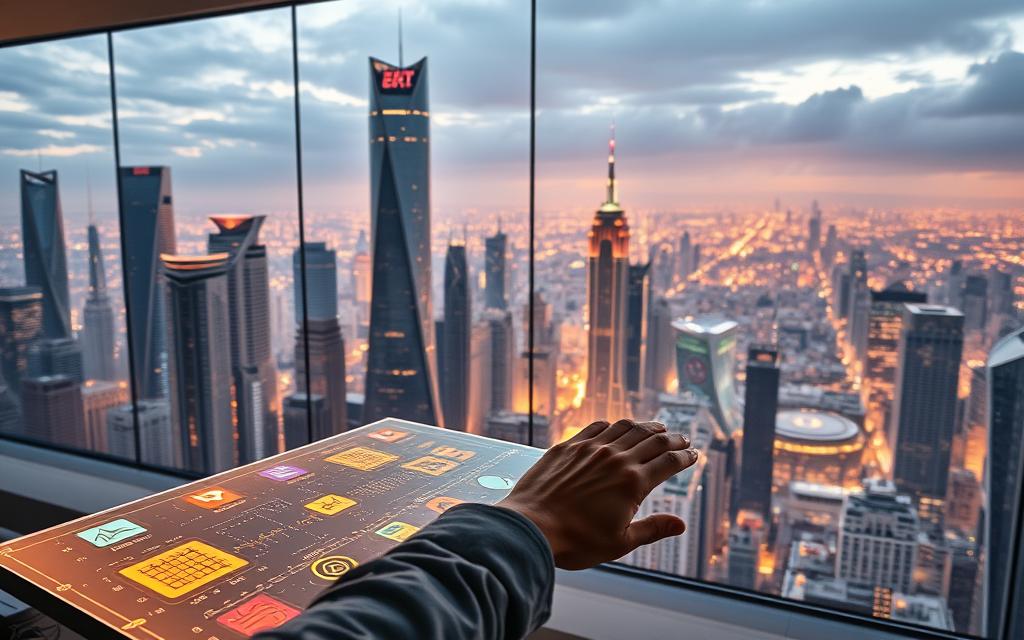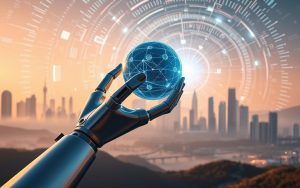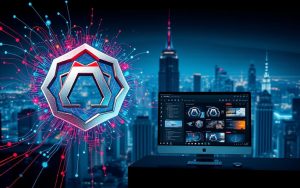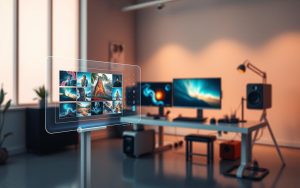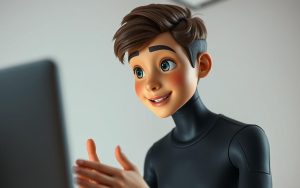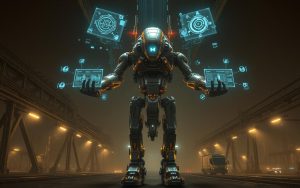Table of Contents
The digital landscape is witnessing a significant transformation with the advent of AI image generators, revolutionizing the way we create visual content. This technology has democratized access to professional-quality visuals, enabling businesses, marketers, designers, and everyday users to enhance their projects with stunning images at the click of a button.
The rapid growth of this technology has been remarkable, with applications across various industries. By allowing instant visualization of concepts and ideas, AI image generators are transforming creative workflows. For instance, businesses can now create professional logos quickly using tools that leverage this technology, as explored in creating stunning business logos with AI.
This accessibility to high-quality visual content is not only enhancing creativity but also streamlining design processes, making it an exciting time for content creators and businesses alike.
Understanding AI Image Generators
AI image generators have revolutionized the way we create visual content. These sophisticated tools utilize artificial intelligence algorithms to convert text descriptions into corresponding images.
What Are AI Image Generators?
AI image generators are advanced software tools that create digital images based on text prompts. Unlike traditional image editing software, these generators produce entirely new visuals rather than manipulating existing ones. The core components of AI image generators include a text input interface, processing algorithms, and image output capabilities.
- Text input interface: Users provide a description of the desired image.
- Processing algorithms: AI analyzes the text prompt and generates an image.
- Image output: The final generated image is produced in various styles and formats.
How AI Image Generation Technology Works
The technology behind AI image generators involves complex neural networks and machine learning models trained on vast datasets of images. When a user inputs a text prompt, the AI interprets the description and translates it into visual elements, colors, styles, and compositions. The process involves analyzing the text description, understanding the context, and rendering the final image.
By understanding how AI image generators work, we can appreciate the complexity and potential of this digital vision technology.
The Evolution of AI Image Generators
From rudimentary beginnings, AI image generators have advanced to sophisticated systems. The journey of these generators has been marked by significant technological advancements, transforming the landscape of digital image creation.
From Early Models to Today’s Sophisticated Systems
Early text-to-image models laid the groundwork for today’s advanced AI image generators. These initial models were limited in their capabilities, producing images that were often simplistic and lacking in detail. However, they paved the way for subsequent innovations. Advancements in neural network architectures, such as GANs (Generative Adversarial Networks) and diffusion models, have been pivotal in enhancing image quality and diversity.
Key Technological Breakthroughs
Several key technological breakthroughs have driven the evolution of AI image generators. Improvements in computing power, particularly GPU technology, have accelerated the development of more powerful image generation models. Additionally, training on larger and more diverse datasets has significantly improved the quality and accuracy of generated images. Recent advancements have also addressed previous limitations in image coherence and adherence to text prompts, resulting in highly detailed and realistic visuals.
Popular AI Image Generator Tools
The world of AI image generation is rapidly evolving, with numerous tools emerging to cater to diverse creative needs. These tools offer a range of features and capabilities, making it easier for users to generate high-quality images.
Bing Image Creator
Bing Image Creator, a Microsoft product, generates AI images from text prompts. Users receive 15 free fast image creations daily, with options to use Microsoft Rewards points for additional fast creations or continue with standard speed.
Fotor AI Art Generator
Fotor AI Art Generator offers various art styles, including concept art, realistic, cartoon, sketch, oil painting, digital art, and 3D for AI image generation. Its user-friendly interface makes it accessible to both professionals and hobbyists.
Other Notable AI Image Generators
Other notable tools include Deep Dream Generator, Prisma, and Artbreeder. Each offers unique features and capabilities, such as transforming photos into works of art in the style of famous artists or creating complex, dreamlike images.
When choosing an AI image generator, consider factors like output quality, ease of use, and pricing models to find the best tool for your specific needs, whether for professional design work, social media content, or personal creative projects.
Benefits of Using AI Image Generators
With the advent of AI image generators, the process of creating high-quality images has become more accessible and streamlined. These tools offer numerous benefits that are transforming the way we approach visual content creation.
Time and Cost Efficiency
AI image generators significantly reduce the time and cost associated with traditional image creation methods. By eliminating the need for expensive stock photo subscriptions or hiring professional photographers and illustrators, businesses can save resources. According to a recent study, companies using AI image generators have seen a notable reduction in their content creation costs.
Accessibility for Non-Artists
These tools democratize visual content creation by making it accessible to non-artists and those without technical design skills. Users can produce high-quality visuals in seconds, rather than the hours or days required for traditional image creation. As
“AI image generators are leveling the playing field for businesses and individuals alike.”
Unlimited Creative Possibilities
AI image generators offer unlimited creative possibilities, allowing users to experiment with different styles, concepts, and visual approaches instantly. This capability helps overcome creative blocks by quickly visualizing ideas and providing inspiration for further development. As a result, content creators, marketers, and designers can enhance their productivity and refine their visual concepts more efficiently.
How to Use an AI Image Generator
Using an AI image generator is a simple, multi-step process that begins with creating an account on your chosen platform.
Creating an Account
To start generating images, you first need to create an account on the AI image generator platform of your choice. For instance, to use Bing Image Creator, users must sign up for a Microsoft Account or sign into an existing one. This process typically involves providing basic information and verifying your email address.
Step-by-Step Process
Once your account is set up, you can begin generating images. The process typically involves describing what you want in the AI picture generator box, choosing the aspect ratio and image style, and clicking “Generate” to create AI-generated images. For example, Fotor AI Art Generator allows users to input text prompts and select from various styles to produce unique creations.
Free vs. Premium Features
Most AI image generators offer both free and premium features. For example, Bing Image Creator provides 15 free fast image creations daily, with the option to use Microsoft Rewards points for additional fast creations. Understanding the difference between free and premium features can help you maximize your image generation experience.
Mastering the Art of Prompt Engineering
To unlock the full potential of AI image generation, understanding prompt engineering is essential. Prompt engineering is the skill of crafting effective text descriptions that produce desired visual outcomes.
Crafting Detailed Descriptions
Crafting detailed descriptions is crucial for achieving precise results with AI image generators. Users should be highly descriptive and imaginative, adding specific details such as adjectives, locations, lighting, and camera angles to enhance the quality of the generated image.
Specifying Art Styles and Compositions
Effectively communicating art styles and compositions through text prompts is vital. Users can specify visual elements like subjects, backgrounds, and mood to evoke specific visual aesthetics. For instance, adding “digital art” or “photorealistic” can significantly influence the output.
Refining and Iterating Your Prompts
The process of refining prompts is iterative. If the initial output isn’t as envisioned, users should adjust and re-prompt by altering themes, style, or specific elements. This iterative process helps achieve the desired image.
| Prompt Element | Description | Example |
|---|---|---|
| Art Style | Specifies the visual aesthetic | Digital art, Photorealistic |
| Composition | Describes the arrangement of elements | Minimalistic, Detailed visuals |
| Lighting | Defines the lighting conditions | Natural, Dramatic |
Practical Applications of AI-Generated Images
AI-generated images are transforming various industries with their versatility and efficiency. These images are being utilized in multiple creative fields, from marketing and social media to design and personal artistic expression.
Marketing and Social Media Content
In the realm of marketing and social media, AI-generated images are being used to create engaging content quickly and cost-effectively. Marketers are leveraging AI image generators to produce advertisements, promotional materials, and social media posts that capture audience attention. For instance, a company can generate multiple versions of an ad with different images to test which performs better.
Design and Illustration Projects
Designers and illustrators are incorporating AI-generated images into their workflows for concept development, mood boards, and final deliverables. AI image generators can produce a wide range of styles and compositions, allowing designers to explore different creative directions. As noted in a recent article on Medium, AI-generated images are being used to enhance design projects.
Personal Creative Expression
AI-generated images are also being used for personal creative expression, such as creating custom artwork for home decor, personalized gifts, and other creative projects. Artists are using AI image generators as tools for inspiration and to expand their stylistic repertoire. The table below summarizes some of the key applications of AI-generated images:
| Application | Description |
|---|---|
| Marketing | Creating engaging ads and promotional materials |
| Design | Concept development and mood boards |
| Personal Art | Custom artwork and personalized gifts |
Ethical Considerations and Limitations
The development of AI image generators has brought to the forefront complex ethical considerations. As these tools become more prevalent, it’s crucial to address the challenges they pose.
Copyright and Ownership Issues
The use of AI image generators raises significant questions about copyright and ownership. Since AI-generated images are created based on patterns learned from existing artworks, determining the rightful owner of the generated image becomes a challenge. Microsoft’s Bing Image Creator, for instance, implements a watermark and content credentials to identify AI-generated images, highlighting the need for transparency in AI-generated content.
Potential for Misuse
AI image generators also carry the risk of being misused to create misleading content, deepfakes, or inappropriate imagery. To mitigate this, platforms like Bing Image Creator have controls in place to prevent the generation of harmful images. When a potentially harmful image is detected, the system blocks the prompt and informs the user.
Responsible AI Image Generation
To ensure the responsible use of AI image generators, it’s essential to adopt best practices. This includes proper disclosure when using AI-generated images in published work and respecting the limitations of current technology. By being aware of these factors, users can harness the creative potential of AI image generators while minimizing their risks.
The Future of AI Image Generators
AI image generation is on the cusp of a significant breakthrough, changing how we create and interact with visual content. As AI image generator technology advances, we can expect substantial improvements in image quality and photorealism. Future developments will likely focus on making these tools more intuitive and accessible, with simplified interfaces and enhanced natural language processing capabilities.
The integration of AI image generators with other creative tools and workflows will create seamless ecosystems, fostering greater creativity and efficiency. Increasing customization options will allow users to exert more precise control over generated images. Moreover, the potential for real-time image generation could revolutionize interactive applications and gaming, opening new avenues for innovation.
As AI image generator technology evolves, it is likely to address current ethical concerns and limitations, ensuring more responsible use. The impact on various industries, from advertising to education, will be significant. To prepare for this shift, individuals and businesses must stay informed about the latest trends and developments in AI image generation technology, leveraging these advancements to drive innovation and growth.
FAQ
What is the primary function of an AI-powered image creation tool?
The primary function is to generate visual content based on text prompts, allowing users to create unique art and designs.
How do I choose the right style for my generated images?
To choose the right style, consider the intended use of the image, such as marketing or personal expression, and experiment with different prompts and styles.
Can I use AI-generated images for commercial purposes?
Yes, but it’s essential to review the terms of service for the specific AI image generator you’re using, as some may have restrictions on commercial use or require credits.
How do I improve the quality of generated images?
To improve quality, provide detailed text prompts, specify lighting and colors, and refine your prompts through iteration.
Are there any free AI image generator tools available?
Yes, several AI image generators offer free versions or trials, such as Bing Image Creator and Fotor AI Art Generator, with varying features and credits.
Can I create images with specific colors or compositions?
Yes, by using detailed prompts and specifying art styles, colors, and compositions, you can achieve the desired visuals.
How do AI image generators handle copyright and ownership?
The issue of copyright and ownership is complex and varies by platform; users should review the terms of service for the specific AI image generator they’re using.


